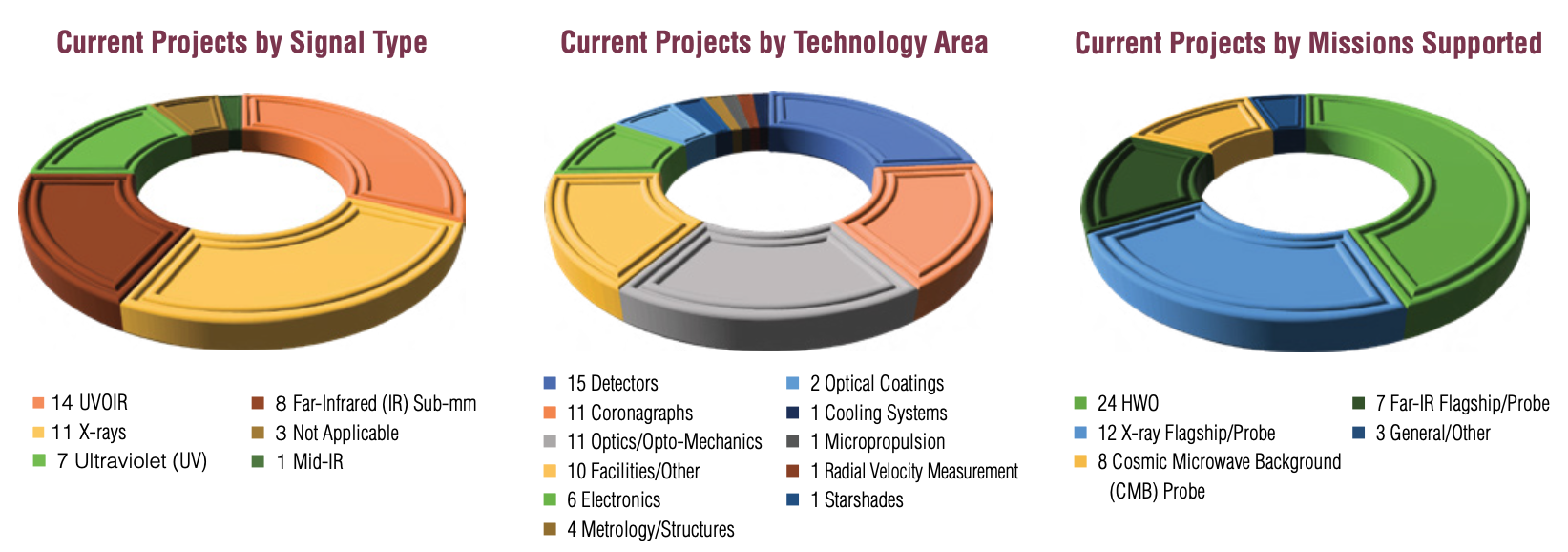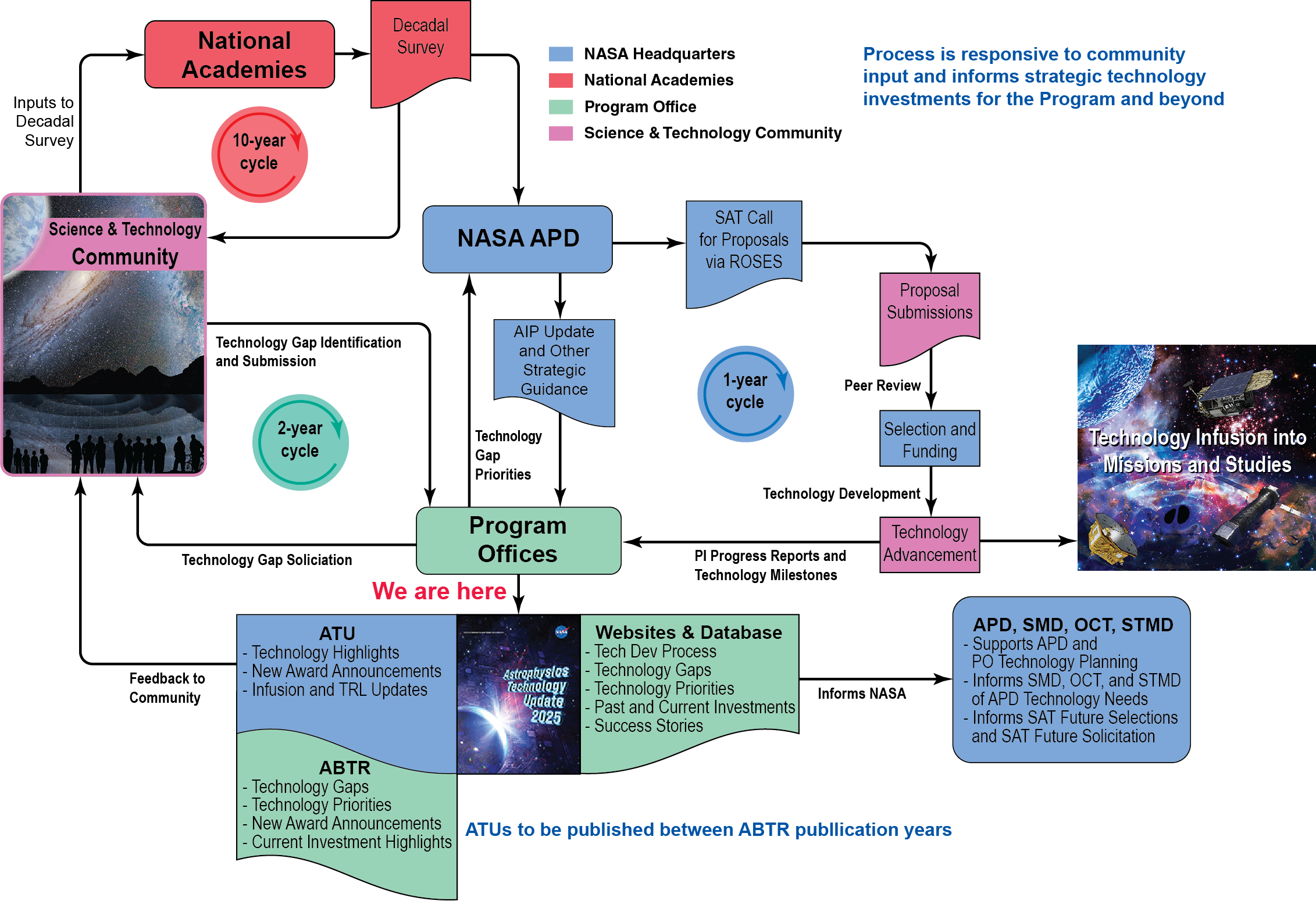Benefits and Technology Maturation
Technology Investment to Date - High Level Overview
- 207 technology and related awards to date (63 are currently active, including 38 SATs).
- 145 SAT projects competitively awarded from 2009 program inception to date, with a 35% proposal win rate in the last three cycles.
- 45 technologies advanced their TRL at least one level to date.
- 100 technologies were infused a total of 236 times into missions or projects (70 technologies 118 times into space missions; 73 technologies 67 times into suborbital missions; and 28 technologies 51 times into ground observatories).
- Over 150 students and postdocs participated in Astrophysics technology projects. Many were then accepted into graduate programs, graduated with a PhD, and/or obtained full-time research positions. Many proceeded to positions at other institutions or high-tech companies. All these contributed to our technology and academic workforce for decades to come, in astrophysics and beyond.
The Big Picture – Astrophysics Technology Development (2009 – 2025)

Astrophysics Program Office Technology Maturation
Identifying, soliciting, and funding strategic technologies requires collaboration and cooperation of many bodies and organizations, including the science and technology community, the National Academies' Decadal Survey panels, APD, and the Program Offices, as shown in the flowchart below. This process comprises three interlinked cyclic processes:
- A 10-year cycle through which the Decadal Survey panels collect and consider community input, and recommend to APD the highest-priority missions and activities for the coming decade or longer, such as Astro2020;
- A biennial cycle through which the Program Offices collect community input and prioritize technology gaps based on APD and Decadal Survey strategic guidance (the Astrophysics Biennial Technology Report, ABTR, and this ATU, are the main reporting step of that cycle); and
- An annual process of soliciting, reviewing, and funding technology development proposals.
The proposal and Notice of Intent due dates for technology development and other solicitations are scheduled to enhance responsiveness and enable prompt proposal evaluations and selection decisions. These due dates can be found in the 2024 ROSES webpage.
Technology Maturations Achieved
PCOS/COR TRL Advances (PI-Asserted Unless Marked as Vetted by Program Office)
2024
- "Demonstrating Large, Low-Noise Transition-Edge-Sensor Arrays for Future Far-IR Space Missions," PI: Johannes Staguhn (JHU), TRL 3 to 4 (2024)
- "Microwave SQUID readout technology development for future X-ray astrophysics missions," PI: Douglas Bennett (NIST), TRL 3 to 4 (2024)
2023
- "LISA UV-LED-based Charge Management Device (CMD)," PI: John Conklin: (UF), TRL 4 to 5 (2023) Vetted
- "Electron-Beam-Lithography Ruled Gratings for Future Ultraviolet/Optical Missions," PI: Brian Fleming (U Colorado), TRL 4 to 5 (2023)
- "E-Beam-Generated Plasma Etching for Developing High-Reflectance Mirrors for Far-UV Astronomical Instrument Applications," PI: Manuel Quijada (GSFC), TRL 3 to 4 (2023) Vetted
- "Single-Photon-Sensing and Photon-Number-Resolving Detector for NASA Missions," PI: Donald Figer (RIT), TRL 4 to 5 for detector layer (2023) Vetted
- "Near-IR LmAPD Arrays for Ultra-Low-Background Space Observations," PI" Michael Bottom (UH Manoa), TRL 3 to 4 (2023) Vetted
2022
- "Advancing High-Density Readout Technology for Superconducting Sensor Arrays for Spaceflight," PI:Larry Ruckman (SLAC), TRL 3 to 4 (2022)
- "Advanced X-ray Optics: Mirror Fabrication (Mandrel and Direct Polishing)," PI: Jeff Kolodziejczak (MSFC), TRL 2 to 3 (2022)
- "Photon-Counting Sensors for UV-Vis Astrophysics Instruments," PI: Oswald Siegmund (UC Berkeley), TRL 4 to 5 (2022) Vetted
2021
- "Photon counting NIR LmAPD Arrays for Ultra-low Background Space Observations," PI: Michael Bottom (UH), TRL 3 to 4 (2021)
"A Single Photon Sensing and Photon Number Resolving Detector for NASA Missions," PI: Donald Figer (RIT), TRL 3 to 4 (2021) - "Electron Beam Lithography Ruled Gratings for Future Ultraviolet/Optical Missions: High-Efficiency and Low-Scatter in the Vacuum Ultraviolet," PI: Brian Fleming (CU Boulder), TRL 3 to 4 (2021)
- "Advanced X-ray Microcalorimeters ISFM Sub-package #1:TES Microcalorimeters," PI: Caroline Kilbourne (GSFC), TRL 3 to 4 (2021)
- "Development of RFSoC-Based Readout Electronics," PI: Philip Mauskopf (ASU), TRL 4 to 5 (2021)
- "Electron-beam Generated Plasma to Enhance Performance of Protected Aluminum Mirrors for Large Space Telescopes," PI: Manuel Quijada (GSFC), TRL 3 to 4 (2021)
- "High Performance Sealed Tube Cross Strip Photon Counting Sensors for UV-Vis Astrophysics Instruments," PI: Oswald Siegmund (UCB), TRL 4 to 5 (2021)
- "Readying X-ray Gratings and Optics for Space Applications: Manufacturability & Alignment," PI: Randall Smith (SAO), MRL 4 to 6 (2021)
- "Development of a Robust, Efficient Process to Produce Scalable, Superconducting kilopixel Far-IR Detector Arrays," PI: Johannes Staguhn (JHU), TRL 3 to 4 (2021)
- "Space-based Gravitational Wave Laser Technology Development Project for the LISA Mission," PDL: Anthony Yu (GSFC), PI: Jordan Camp (GSFC), TRL 4 to 5 (2021)
- "Next Generation X-ray Optics," PI: William Zhang (GSFC), TRL 4 to 5 (2021)
2020
- "Scalable Micro-Shutter Systems for UV, Visible, and Infrared Spectroscopy," PI: Matthew Greenhouse (GSFC), TRL 3 to 4 (2020)
- "Phase Measurement System Development for Interferometric Gravitational Wave Detectors," PI: William Klipstein (JPL), TRL 4 to 5 (2020)
- "Advancing the Focal Plane TRL for LiteBIRD and Other Next Generation CMB Space Missions," PI: Adrian Lee (UCB), TRL 3 to 5 (2020)
- "Advanced FUVUV/Visible Photon Counting and Ultralow Noise Detectors," PI: Shouleh Nikzad (JPL), TRL 3 to 4 (2020)
- "Predictive Thermal Control (PTC) Performance Tests," PI: H. Philip Stahl (MSFC), TRL 3 to 5 (2020)
2019
- Planar Antenna-Coupled Superconducting Detectors for CMB Polarimetry," PI: James Bock (JPL), TRL 3 to 4 (2019)
- "LISA UV-LED-Based Charge Management System," PI: John Conklin (UF), TRL 3 to 4 (2019) Vetted
- "Providing Enabling & Enhancing Technologies for a Demonstration Model of the Athena X-IFU," PI: Caroline Kilbourne (GSFC), TRL 3 to 4 (2019)
- "Space-based Gravitational Wave Laser Technology Development Project for the LISA Mission," PDL: Anthony Yu (GSFC), PI: Jordan Camp (GSFC), TRL 3 to 4 (2019)
2018
- "Advanced X-ray Optics ISFM Sub-package #2: Direct Fabrication of Full Shells," PI: Stephen Bongiorno (MSFC), TRL 2 to 3 (2018)
- "Advanced X-ray Optics ISFM Sub-package #4: Low Stress Mirror Coatings," PI: David Broadway, TRL 2 to 3 (2018)
- "Development of Digital Micro-Mirror Device Arrays for Use in Future Space Missions," PI: Zoran Ninkov (RIT), TRL 4 to 5 (2018)
"Advanced UVOIR Mirror Technology Development for Very Large Space Telescopes," PI: H. Philip Stahl (MSFC), TRL 3 to 4 (2018) Vetted
2017
- "Ultraviolet Coatings, Materials and Processes for Advanced Telescope Optics," PI: Kunjithapatham Balasubramanian (JPL), TRL 2 to 3 (2017)
- "Fast Event Recognition for the Athena Wide-Field Imager," PI: David Burrows (PSU), TRL 3 to 5 (2017) Vetted
- "Raising the TRL of 4.7-THz Local Oscillators," PI: Qing Hu (MIT), TRL 3 to 4 (2017)
- "High-Resolution and Lightweight X-ray Optics for the X-Ray Surveyor," PI: William Zhang (GSFC), TRL 3 to 4 (2017)
2016
- "X-ray Reflection Grating Module Development," PI: Randall McEntaffer (UI), TRL 3 to 4 (2016) Vetted
- "Advanced Packaging for Critical-Angle X-ray Transmission Gratings," PI: Mark Schattenburg (MIT), TRL 3 to 4 (2016) Vetted
2015
- "Colloid Microthruster Propellant Feed System for Gravity Wave Astrophysics Missions," PI: John Ziemer (JPL), TRL 4 to 5 (2015)
2014
- "Development of Digital Micromirror Device (DMD) Arrays for Use in Future Space Missions," PI: Zoran Ninkov (RIT), TRL 3 to 4 (2014)
- "TRL Advancement for Al+MgF2 Mirrors for FUV Space Astronomy," PI: Manuel Quijada (GSFC), TRL 3 to 4 (2014)
- "Next Generation X-ray Optics: High Resolution, Light Weight, and Low Cost," PI: William Zhang (GSFC), TRL 4 to 5 (2014)
- "Colloid Microthruster Propellant Feed System for Gravity Wave Astrophysics Missions," PI: John Ziemer (JPL), TRL 3 to 4 (2014)
2013
- "Heterodyne Technology For SOFIA," PI: Paul Goldsmith (JPL), TRL 3 to 4 (2013)
- "Adjustable X-ray optics with Sub-Arcsecond Imaging," Paul Reid (SAO), TRL 2 to 3 (2013)
- "Next Generation X-ray Optics: High Angular Resolution, High Throughput, and Low Cost," PI: William Zhang (GSFC), TRL 3 to 4 (2013)
2012
- "Telescopes for Space-Based Gravitational-Wave Observatories," PI: Jeffrey Livas (GSFC), TRL 2 to 3 (2012)
Technology Infusions
APD’s technology development investments have advanced TRLs of dozens of technologies and led to 170 infusions and 66 potential infusions into space, suborbital, and ground-based missions and projects. Infusion here means that a technology was implemented in a mission/project (Implemented), baselined by a mission (Planned), or incorporated into a strategic mission concept’s reference design (Concepts/Studies). Technologies developed for strategic astrophysics missions often find applications beyond strategic missions, including Probes, Explorers, sub-orbital rockets, balloon missions, and ground-based projects. Further, applications aren’t limited to astrophysics, with technologies being infused into cross-cutting applications in Earth Science, Planetary Science, and Heliophysics.





























